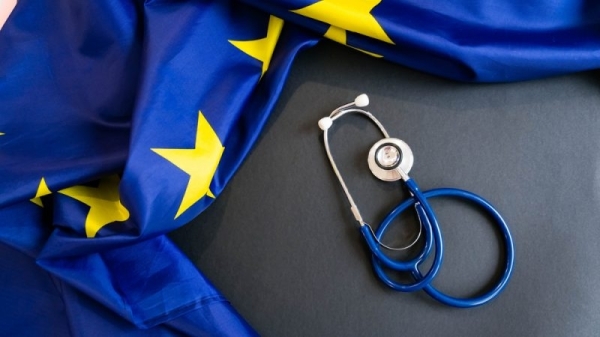Brussels urged to address EU health workforce ‘ticking bomb’

An increasingly disproportional migration of health workers within the EU has resulted in a workforce crisis as several member states face staff shortages putting health systems’ sustainability at risk. Although the EU’s role is limited, stakeholders say quick solutions can be found.
EU member states’ health systems are under stress due to a severe healthcare staff shortage, according to a 2021 report from the Commission.
Contrary to the EU push for ‘upward convergence’, the report showcases a disparity in healthcare among EU member states.
For example, Romania and Poland have lower densities of doctors and nurses than Germany and Sweden, partly explained by intra-EU migration.
Critics suggest that all member states are struggling with the same problem and fishing in the same pond, with the richer member states winning the game.
“Romania, Italy, Greece and all the eastern European countries are the most looted and impoverished by this process of stripping skilled workforce and brilliant brains”, Gugliemo Trovato, director of communications of the European Medical Association, told EURACTIV.
Trovato stressed that better salaries, facilities, and training opportunities are among the reasons why health workers decide to migrate.
Similarly, the European Federation of Nurses emphasises that staff shortages are a severe issue affecting the entire EU, not only eastern and southern member states.
“The situation is bad everywhere […] All EU member states are suffering from shortages,” EFN Secretary General Paul de Raeve told EURACTIV, adding that “hospitals close down units because there are no nurses.”
De Vries also called nursing staff shortages a “ticking bomb”.
Several EU lawmakers argue that the EU should be more involved in finding a solution, however, it’s not an easy task, considering that the EU has limited competences in the health field.
An EU official told EURACTIV that according to the EU Treaty, the Commission’s actions are limited as member states are responsible for managing health services and medical care.
The Commission, however, is aware of health workers shortages, as well as the disparities between member states and the difficulty of some countries to retain professionals, the EU official said.
The EU official emphasised that the executive is already adopting measures to address the multi-layered health workers issues under the EU4Health programme.
One of these measures is the member state Joint Action on Health Workforce Planning and Forecasting ‘Heroes’ launched in February 2023, aiming to improve staffing planning capacities and policies.
MEPs call for action
“It is up to the EU and its institutions to flank and complement the actions of individual European countries,” S&D MEP Annalisa Tardino told EURACTIV, adding that the institutions should encourage collaboration and support the measures and interventions of member states.
Her colleague Tudor Ciuhodaru, also a medical doctor, said more funds are needed.
“The healthy solution I propose, according to the model of each state’s percentage contribution to NATO, let’s do the same thing about health financing,” Ciuhodaru told EURACTIV, adding that there is a need for a “revolution in health”.
MEP István Ujhelyi believes the EU should have a more active role in stimulating the growth of health systems across all member states, and this could be achieved through a true European Health Union.
“Since the beginning of my mandate, I have called for a European health union and a single health, starting from the development of European quality standards in health and up to financing policies that guarantee fair access to health. Unity in diversity, the motto of the European Union, must also mean equal access to health,” the Hungarian politician said.
The steps EU could take
For WEMOS, an NGO dealing with health policy research, Europe’s main “promise” is being broken.
“We’re failing to deliver on the promise we made, to member states and to the people in the member states, that in the EU, we will prosper together, in solidarity,” said Corinne Hinlopen, Global health policy researcher at WEMOS.
Despite its limited competence, the NGO believes the EU could take specific steps to improve the situation. However, the EU must first fully understand what is happening in the health labour market.
These measures could range from giving explicit attention to health workforce issues at the EU health ministers’ meetings to discussing the issue across the different DGs of the European Commission and not only within the one related to health (DG SANTE).
Another policy measure is collecting the proper data at the EU level, as currently there are many sources, but still not a clear picture of the situation.
For instance, this data could be communicated through the European Semester, a tool the Commission uses to provide member states with policy recommendations in various fields of the economy.
WEMOS suggests mandatory reporting on health worker densities in member states, countries’ self-sufficiency in health worker training and education or reliance on foreign-trained and foreign-born health workers.
For the NGO, the data collection could happen either by setting up a new entity or via existing ones, such as the European Observatory on Health Systems and Policies or ECDC.
Regarding the funding, WEMOS insists that the EU should encourage member states to use various tools, from the Recovery Fund to cohesion funds and the European Investment Bank.
“The cost of inaction is huge […] we should realise that countries like Romania, Estonia, Slovakia, Hungary have in the past 12 years seen so many doctors leaving that they would make up to 20-25% of their current doctors’ health workforce size,” Hinlopen concluded.
(Edited by Sarantis Michalopoulos | EURACTIV.com, Alice Taylor | EURACTIV.com)



